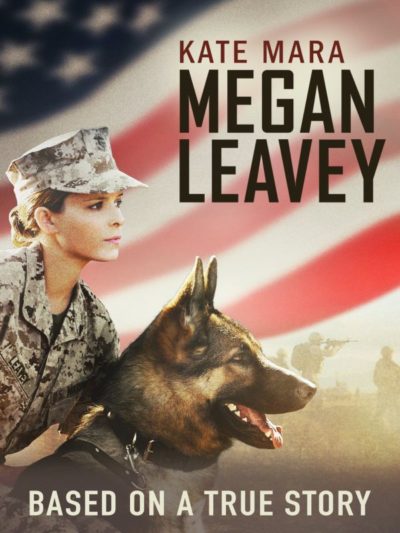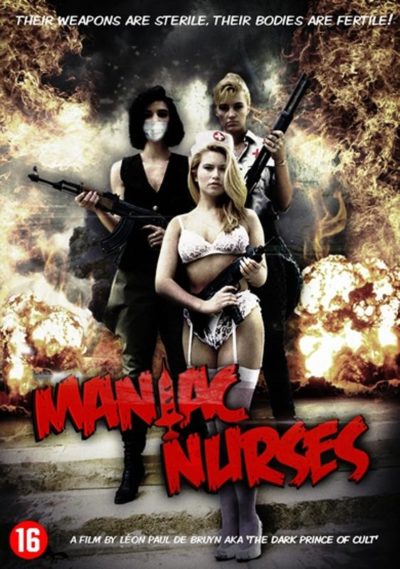★★★
“A tale of dogged determination.”
 The crossing of war and animal genres of film isn’t one with much precedent, and you can see why: it would be difficult to balance those disparate elements. While this does a laudable effort, and manages to avoid sliding too far into the slippery road of sentimentality, it offers few surprises, even if you don’t know the true story on which it’s based.
The crossing of war and animal genres of film isn’t one with much precedent, and you can see why: it would be difficult to balance those disparate elements. While this does a laudable effort, and manages to avoid sliding too far into the slippery road of sentimentality, it offers few surprises, even if you don’t know the true story on which it’s based.
Megan Leavey (Mara) opts to join the Marines after the death of her best friend leaves her feeling rudderless. While she gets through boot-camp successfully, she’s teetering on the edge of a discharge when a punishment detail introduces her to the canine corps. There, she meets Rex (Varco), a bomb-sniffing dog with whom she makes a connection – despite the mutt having issues of his own. Eventually, Megan gets assigned to the corps. She and Rex are sent to Iraq, where they have the hazardous task of finding the roadside IEDs, (Improvised Explosive Devices), an ever-present threat to American forces.
It’s there that the film is probably at its best, capturing the real sense of danger, lurking around every corner and in every encounter. It’s the little things which are most chilling: she’s scolded for telling an Iraqi kid Rex’s name, because it could be used against them. Turns out, the insurgents offer a bounty on dog handlers – particularly female ones. You’ll spend a good chunk of this time on the edge of your seat, knowing that “something” is going to happen, in a way I’ve don’t think I’ve experienced since The Hurt Locker.
Eventually, something does, and the film enters the second stage. Megan leaves the armed forces, suffering from injuries both physical and mental, and wants to take Rex with her. The military, however, have other plans, and he is sent back for another tour of duty. Megan becomes a relentless pest on his behalf, and when Rex is eventually set for retirement, ramps up the campaign to be allowed to adopt her partner. Except, he has been officially tagged as “unadoptable”, and incapable of being re-introduced to civilian life – effectively, a death sentence.
It’s interesting that this was re-titled for the dog in the British market, perhaps reflecting a different audience. And to be honest, I’m a cat person, which perhaps limits the impact this tale (tail?) of canine-human devotion will have. It all seems a bit one-sided: what exactly did Rex do to justify all Megan’s efforts? I’ll happily accept our cat sitting on my head and purring loudly at 6am, even if I suspect it’s less an expression of affection, than closer to “Get up and feed me, you lazy bastard.”
But regardless of species, any pet owner knows what it’s like to care, and by the end, you will be rooting for Megan to triumph. Mara’s performance is a winning one, and director Cowperthwaite is no stranger to emotionally-driven animal stories, though the work for which she’s best-known is the killer whale documentary, Blackfish. Despite some pacing problems, especially after the heroine returns home, the heart present here is undeniable, and makes for a decent movie to curl up with, alongside your animal companion of choice.
Dir: Gabriela Cowperthwaite
Star: Kate Mara, Varco, Ramon Rodriguez, Common
a.k.a Rex





 This low-key Lifetime movie stars Carpenter as a literal soccer mom, Anne Harding, right down to the minivan she drives, taking daughter Denise (Grey) to her practice. Denise is a hot prospect, with college scholarships beckoning. However, life for the rest of the family is not so smooth. Anne lost her husband and is in financial difficulties, mostly because of the never-ending gambling debts run up by her other child, Kyle (DiMarco) to local thug Quinlan (Mitchell). Anne has tried to help, only to find herself robbing banks on behalf of the boss. It helps that she wears a fake beard and mustache, so the police are looking for completely the wrong gender. But it takes its toll on an increasingly-twitchy Anne, with Denise eventually putting together the pieces to realize her mother is responsible for the recent crime spree.
This low-key Lifetime movie stars Carpenter as a literal soccer mom, Anne Harding, right down to the minivan she drives, taking daughter Denise (Grey) to her practice. Denise is a hot prospect, with college scholarships beckoning. However, life for the rest of the family is not so smooth. Anne lost her husband and is in financial difficulties, mostly because of the never-ending gambling debts run up by her other child, Kyle (DiMarco) to local thug Quinlan (Mitchell). Anne has tried to help, only to find herself robbing banks on behalf of the boss. It helps that she wears a fake beard and mustache, so the police are looking for completely the wrong gender. But it takes its toll on an increasingly-twitchy Anne, with Denise eventually putting together the pieces to realize her mother is responsible for the recent crime spree. The German-Canadian co-production is split into two feature-length parts – “Dragonfly” and “Energy” – but is absolutely a single entity, so that’s how it’ll be covered here. I was braced for something truly dreadful, after reading some particularly scathing reviews, and seeing no less than
The German-Canadian co-production is split into two feature-length parts – “Dragonfly” and “Energy” – but is absolutely a single entity, so that’s how it’ll be covered here. I was braced for something truly dreadful, after reading some particularly scathing reviews, and seeing no less than  That this Belgian flick starts off with a dedication to Ilona Staller (a.k.a. Italian porn star, Cicciolina), artist provocateur Jeff Koons, and Traci Lorde, likely tells you it should not be taken too seriously. Certainly, the amusement to be found largely requires the viewer to be aware of the genres to which this is a homage. This is best exemplified by the
That this Belgian flick starts off with a dedication to Ilona Staller (a.k.a. Italian porn star, Cicciolina), artist provocateur Jeff Koons, and Traci Lorde, likely tells you it should not be taken too seriously. Certainly, the amusement to be found largely requires the viewer to be aware of the genres to which this is a homage. This is best exemplified by the  ★★★★
★★★★ The WWE and women’s wrestling have had a fractious relationship over the years. For every two steps forward, there has been one – or, more often, two – backward. But under Executive Vice President of Talent Paul M. Levesque, better known by his ring-name of Triple H, there have been hopeful signs of progress. Perhaps the biggest of late was WWE staging an all-woman tournament this year, featuring 32 wrestlers from 13 different countries. This was named the Mae Young Classic, in honour of one of the field’s pioneers and longest-serving members; she wrestled from 1939 through 2008, and passed away in 2014.
The WWE and women’s wrestling have had a fractious relationship over the years. For every two steps forward, there has been one – or, more often, two – backward. But under Executive Vice President of Talent Paul M. Levesque, better known by his ring-name of Triple H, there have been hopeful signs of progress. Perhaps the biggest of late was WWE staging an all-woman tournament this year, featuring 32 wrestlers from 13 different countries. This was named the Mae Young Classic, in honour of one of the field’s pioneers and longest-serving members; she wrestled from 1939 through 2008, and passed away in 2014.
 As a joke I saw on Facebook went, “With all these self-driving cars, it won’t be long before there’s a country song about your truck leaving you.” The rise of smart vehicles is inevitable, and likely, so are other films like this, which falls somewhere between Christine and 2001. In this case, mother Sandra (Bowden) is driving to see her husband, whom she suspects of cheating on her, with their young child David (played by the two Hodges brothers, whom I’m assuming are twins!) in the back seat. Her car is the state-of-the-art Monolith, equipped with every safety feature imaginable, and then some. But a series of events – a diversion, an encounter with roadkill on the hoof, and Sandra giving David her smartphone as a distraction – lead to a tricky situation. She is stuck on a remote desert road, outside of a car that has now entered its impenetrable “vault mode”, with David trapped in its interior.
As a joke I saw on Facebook went, “With all these self-driving cars, it won’t be long before there’s a country song about your truck leaving you.” The rise of smart vehicles is inevitable, and likely, so are other films like this, which falls somewhere between Christine and 2001. In this case, mother Sandra (Bowden) is driving to see her husband, whom she suspects of cheating on her, with their young child David (played by the two Hodges brothers, whom I’m assuming are twins!) in the back seat. Her car is the state-of-the-art Monolith, equipped with every safety feature imaginable, and then some. But a series of events – a diversion, an encounter with roadkill on the hoof, and Sandra giving David her smartphone as a distraction – lead to a tricky situation. She is stuck on a remote desert road, outside of a car that has now entered its impenetrable “vault mode”, with David trapped in its interior. I say the above, since the father of the star here is Clint Eastwood, possibly the most famous vigilante in cinematic history. He gave us Dirty Harry, who memorably spat out lines such as, “When an adult male is chasing a female with intent to commit rape, I shoot the bastard – that’s my policy.” This apple doesn’t fall far from the tree. Though Noelle, the art student who becomes an avenging force after being raped at a party by a fellow student, takes a little longer to get to that point of unrepentant street justice. Her first victim is purely accidental, her attacker falling over a balcony after she confronts him, in the hope of getting some kind of apology. Doesn’t happen, and his death doesn’t exactly cause her sorrow. When she realizes she is also far from alone in what she has gone through, she decides that active retaliation is the best approach.
I say the above, since the father of the star here is Clint Eastwood, possibly the most famous vigilante in cinematic history. He gave us Dirty Harry, who memorably spat out lines such as, “When an adult male is chasing a female with intent to commit rape, I shoot the bastard – that’s my policy.” This apple doesn’t fall far from the tree. Though Noelle, the art student who becomes an avenging force after being raped at a party by a fellow student, takes a little longer to get to that point of unrepentant street justice. Her first victim is purely accidental, her attacker falling over a balcony after she confronts him, in the hope of getting some kind of apology. Doesn’t happen, and his death doesn’t exactly cause her sorrow. When she realizes she is also far from alone in what she has gone through, she decides that active retaliation is the best approach. I’m not sure if the problems here are a result of there being two authors credited on this story. It could certainly explain them. For rather than providing a single coherent vision, this feels like both its universe and characters are being pulled in too many different directions. It’s overstuffed with ideas and, instead of them being developed fully, scurries from one to the next, as if the writers were competing to have the final word. This comes to an end in a rather ludicrous finale. There, the entire plot takes a right turn, with the biological weapon which has formed much of the early focus all but discarded.
I’m not sure if the problems here are a result of there being two authors credited on this story. It could certainly explain them. For rather than providing a single coherent vision, this feels like both its universe and characters are being pulled in too many different directions. It’s overstuffed with ideas and, instead of them being developed fully, scurries from one to the next, as if the writers were competing to have the final word. This comes to an end in a rather ludicrous finale. There, the entire plot takes a right turn, with the biological weapon which has formed much of the early focus all but discarded.
 I think it was only as the end credits were rolling, that I perhaps appreciated this series fully. Sure, in many ways, these films have been a poor man’s Lord of the Rings knock-off, with a disparate band of hardy adventurers on a quest to stop Ultimate Evil (TM) from taking over. But, dammit, I found myself enjoying them, appreciating their smaller-scale charms and actually liking the characters – possibly even more than Frodo. While this finale doesn’t sustain the non-stop pace of its most recent predecessor, it does a good job of tying up all the loose ends. And if you’ve watched all five, and don’t have a slight moistness around the eyes at the end, you’ve a harder heart than I.
I think it was only as the end credits were rolling, that I perhaps appreciated this series fully. Sure, in many ways, these films have been a poor man’s Lord of the Rings knock-off, with a disparate band of hardy adventurers on a quest to stop Ultimate Evil (TM) from taking over. But, dammit, I found myself enjoying them, appreciating their smaller-scale charms and actually liking the characters – possibly even more than Frodo. While this finale doesn’t sustain the non-stop pace of its most recent predecessor, it does a good job of tying up all the loose ends. And if you’ve watched all five, and don’t have a slight moistness around the eyes at the end, you’ve a harder heart than I.